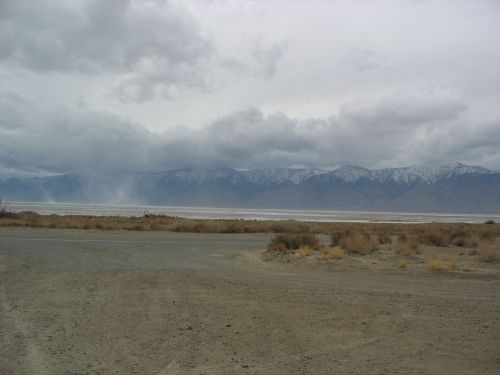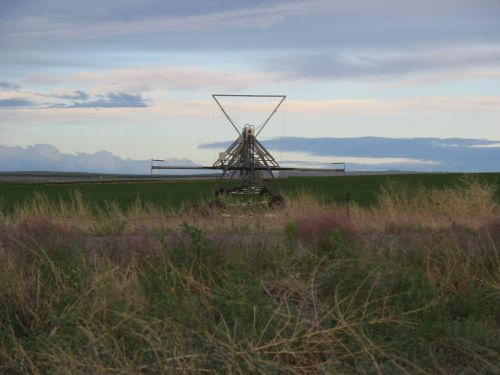
Atlatl Petroglyph at Atlatl Rock, Valley of Fire State Park
I’ve decided to do a series of posts on the issue of prehistoric weaponry and the spread of the bow and arrow through North America. This is an important topic, and one that has received a considerable amount of attention from archaeologists and others over the past century. Despite that long history of research, there are still a lot of unresolved questions about this, and it has been a highly contentious issue in some circles.

Petroglyph Panel at Atlatl Rock, Valley of Fire State Park
To frame the issue, and to demonstrate its importance to Chaco specifically and Southwestern archaeology more generally, I’d like to go back to a topic I haven’t discussed much lately: warfare, and in particular Steven LeBlanc’s book on warfare in the prehistoric Southwest. This is a controversial issue, although most Southwestern archaeologists seem to be coming around to the view that warfare was important even if they don’t see it as central the way LeBlanc does. Leaving all that aside for now, however, LeBlanc also provides a useful model for the spread of prehistoric weaponry in the Southwest that clearly shows the importance of the bow and arrow. He uses weaponry type as one of the defining features of the three periods into which he divides Southwestern prehistory from the perspective of warfare. Each period is marked by the adoption of a new type of weapon, in each case more effective than the last. The periods don’t quite line up with the probable dates of adoption of the new weapons, however, which suggests that there was more going on than mere technological developments. This has to be the case, actually, because LeBlanc’s middle period (AD 900 to 1150, which roughly coincides with the Chacoan era) is marked by a noteworthy decrease in evidence for warfare despite coming not long after the introduction of the bow and arrow to the Southwest.

Arrowheads at Chaco Visitor Center Museum
LeBlanc’s early period, which runs from the first settlement of the Southwest up to around AD 900, was marked by endemic warfare among small groups using atlatls. The atlatl, known by various other names such as “spear-thrower” but in this context usually called by its Nahuatl name, is a tool used to launch spears (often called “atlatl darts”) with greater force and to a greater distance than is possible with the unaided hand. It is found in every inhabited part of the world starting in very early times, and probably dates far back into the Paleolithic Era, before the spread of modern humans throughout the world. It was thus presumably known to the earliest inhabitants of both the Americas in general and the Southwest in particular. Most archaeologists generally think of the atlatl in a hunting context, and it would certainly have been used for hunting. LeBlanc, however, points out that any weapon used for hunting would also be useful in war, and since he proposes that war was going on constantly during his early period, it stands to reason that the main weapon would have been the atlatl. He also argues that the large wooden club-like artifacts found in sites of this era, often known as “rabbit sticks” and associated with hunting of small game, were instead “fending sticks” used to deflect atlatl darts. I’m not sure I buy this, but it does make sense that people fighting with atlatls would want to do something to defend themselves against darts coming at them and the sticks would work. Support for the idea that the atlatl was a weapon of war in addition to a hunting tool comes from Mesoamerica, where military use of the atlatl came to be a major feature of the very warlike societies there.

"Rush to the Rockies" Sign, Trinidad, Colorado
At some point near the end of LeBlanc’s early period, a new weapon system appeared in the Southwest: the bow and arrow. The spread of the bow and arrow is fascinating, since unlike almost all other examples of diffusion of ideas and technologies through North America it came not from the south but from the north. It originated somewhere in Eurasia very early on, and then spread very slowly to the Bering Strait, and from there on down the continent. The most interesting part, and something that I’ll be addressing in more detail in subsequent posts in this series, is that it’s possible to track the movement of the bow and arrow south from the Arctic by looking at the first appearance of it in rock art and artifact assemblages at sites in various areas. It reached the Southwest sometime around the Pueblo I period and immediately replaced the atlatl as the preferred weapon for both hunting and (presumably) war. It then continued to spread to the south, but for some reason it didn’t really catch on in Mesoamerica the way it had in most of the areas to the north. This may have been because of the cultural importance of the atlatl, but it could also have been because it had just barely reached central Mexico when the Spanish arrived and threw everything into chaos. In fact, I’m not entirely sure it got as far as central Mexico at all; I haven’t found any sources that discuss this precise issue, although there’s been so much attention paid to Aztec warfare that I’m sure it’s discussed somewhere. It definitely never reached the Maya. All these Mesoamerican groups were still using the atlatl as their primary weapon when the Spanish showed up with guns.

Sign for Atlatl Rock, Valley of Fire State Park
LeBlanc’s late period, from AD 1250 until Spanish contact, is associated with the use of the recurved bow, which is a more powerful weapon than the self bow that had been used before and may have had something to do with the immense amount of violence that is evident in the Southwest during this period. This is an interesting topic in its own right, but I’m not really going to go into it in this series, which is more focused on the initial adoption of the (self) bow and arrow in various parts of North America.

Stairs to Atlatl Petroglyph at Atlatl Rock, Valley of Fire State Park
Okay, so, that seems pretty straightforward, doesn’t it? If there is clear evidence for the spread of the bow from Asia into North America and then south, where’s the controversy? Well, I was a bit too glib above in saying that the spread of the bow and arrow can be easily tracked by looking at its first appearance in the archaeological record in various areas. The general picture still holds, I think, but the details are muddled, and there is considerable disagreement among archaeologists about what counts as evidence for the introduction of the bow and arrow in some regions. The main reason for this is that in most areas, the actual bows and arrowshafts don’t survive, since they’re made of perishable materials. Nor, for that matter, do atlatls, at least in their entirety. The main remains of both types of weapons are the projectile points, which are usually made of hard stone. Atlatls also can have parts attached to them (known as “spurs” and “weights”) which are made of harder materials like stone or bone, and these can survive even when the wooden body of the atlatl doesn’t, although they can be hard to recognize on their own. In general, then, dating the replacement of the atlatl by the bow and arrow requires the ability to differentiate between dart points and arrowheads. Since atlatl darts are spears, it is generally thought that they should have bigger, heavier points than arrows, and size is indeed one criterion used to differentiate between the two types of point. This is controversial, however, for reasons that I’ll go into in future posts.

Hollow Mountain Gas Station, Hanksville, Utah
The entry of the bow and arrow into the Southwest, by the way, is dated much more precisely than is the case in other reasons, primarily because the much better preservation conditions in many Southwestern contexts mean that actual atlatls, darts, bows, and arrows do often survive, which allows a much better understanding of what they were like than is possible elsewhere. This has been very helpful in getting a sense of the situation elsewhere, although other factors mean that it can’t answer all the questions about those other places. This importance of the Southwest to understanding the spread of the bow and arrow, despite not being the area where that spread either began or ended, makes this blog a good place for an examination of the issue, as does the importance of that spread to understanding cultural developments in the Southwest. Those developments seem to have something to do with changes in weaponry, although the precise connection is difficult to discern.

Parking Lot for Atlatl Rock, Valley of Fire State Park
Read Full Post »










































